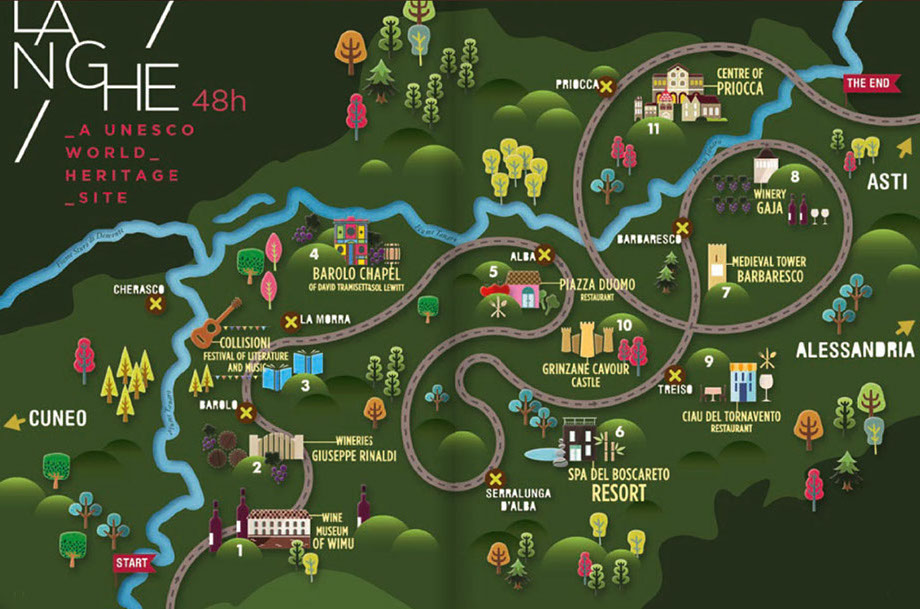48 Hours in ... The Langhe, Piedmont

Return to Top
Return to "48 Hours In" Menu
Return to "Rome" Menu
Here is a territory in southern Piedmont that stretches over 100 square kilometres and straddles the provinces of Alessandria, Asti and Cuneao, surrounded by both Alps and Apennines and offering unforgettable hilly landscapes. This is the Langhe-Roero in Monferrato area recently named a UNESCO World Heritage site. This prized land does not just offer natural wonders or architectural and historic attractions. It is also the area where some of the world's finest wines are made, a feature that made no small contribution towards its UNESCO recognition. We are speaking of some of Italy’s most enduring reds, such as Barolo and Barbaresco, but also of some young, pleasing ones like Barbera and Dolcetto.
Travelling the roads on the crests of the hills between Belbo and Tanaro you come upon the Barolo area, with two mediaeval castles facing one another. In one you can visit the Barolo wine museum (1). Also recommended is a stroll in the village and of course a visit to the wine cellars of small producers including the encyclopaedic Giuseppe Rinaldi (2), who is emblematic of both the local culture and its temperament. In Barolo, July is the time for Collisioni (3), a festival of literature and music featuring the most important names in music and international culture.
Proceeding for a few kilometres to la Morra, admire one of the Langhe areas most highly prized vistas. Also a must are the David Tramiett and Sol LeWitt Barolo (4), set among the vineyards and the age old vaulted wine cellars of Fontannafredda. If it is evening, come down from the hills to Alba for a dinner in one of Italy's finest restaurants (if you can afford it), Piazza Duomo (5). Chef Enrico Crippa will delight you with his technical refinement, serving the most convincing flavours of Italian cuisine and of the Langhe area, accompanying it with some of the finest vintages. It is a gourmet experience that cannot be missed, perhaps during the white truffle fair held in October/November. During that time there is no harm in visiting the Boscareto Resort spa (6) in Serralunga d’Alba, which has good (and express) cuisine as well as good (and expensive) rooms for those who wish to stay up in the hills. Otherwise, and also in the hills, there is the delightful Relaisalayah Villa d’Arnelia, with a pool in the summer, affordable prices, find service and very cosy rooms. As we reach Neive, we enter the area of the Barbaresco hills, where we can admire in the town the magnificent mediaeval tower (7). If you can drop into the best known Italian winery in the world, Gaia (8), located in the Barbaresco castle. Also a can't miss (and affordable) experience is lunch at Antica Torre: tajarin pasta and raw meat. At dinner, you might venture a visit to LA Ciau del Tornavento (9) in Trentiso, with higher quality and higher prices but with flavours at that just cannot be missed. Here you might also stop for the night.
The most important castle on the whole territory is Grinzane Cavour (10), which for 20 years was home to the Count of Cavour, famed as a leading figure in Italian unification. It now houses Piedmont's first regional wine cellar. Moving into the heart of Monferrato we come to Nizza Monferrato, the capital of Barbera and a magnificent specimen of a mediaeval city. Also in Monferrato, visit the characteristic infernot cellars dug into the typical Pietra da Canton stone. For a final bubbly and toast, go onto Canelli in the Moscato Bianco area that produces Asti spumante. 20 minutes from town is a restaurant essential for those who wish to enjoy the dishes most characteristic of the Langhe area in their most local and authentic version, Il Centro at Priocca (11).